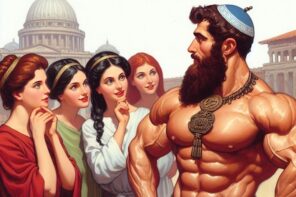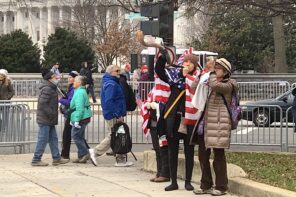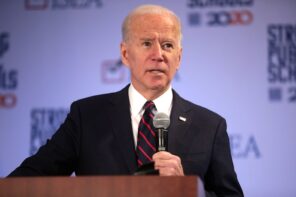Mitt Romney is making a big push for the Jewish vote. In classic Romney (i.e., clueless) form, his campaign scheduled a trip to Israel on the Jewish fast day of Tisha B’Av. Gershom Gorenberg writes at the Daily Beast:
It seems no one on his staff checked a Jewish calendar and noticed that he’d spending most of his time in Israel on the fast day of Tisha B’Av. His big fundraising event was originally scheduled for Sunday evening—just after the fast ends, but close enough to spark a public outcry that surprised the campaign, according to a Republican strategist. The event was moved to Monday morning.
Whoops! This from the campaign that’s making a big push for Jewish voters, with the financial backing of casino magnate Sheldon Adelson. On MSNBC this morning, Matt Brooks of the Republican Jewish Coalition was expressing confidence that Obama will have a Jewish problem come election time—based on conversations Brooks has had with Jews around the country who want to . . . have a conversation with the head of the Republican Jewish Coalition. Imagine that!
That even Romney’s Jewish backers failed to notice the scheduling conflict with a fast day has got to poke a serious hole in their claims to be the guardians of Jewish identity and Israel.
Tisha B’Av, meaning the ninth day of the month of Av, marks the destruction by the Babylonians of the Temple of Solomon in 586 BCE, and of the Second Temple by the Romans in 70 CE. (This year the ninth day falls on Shabbat, so the fast is on the next day, Sunday.) Not only does it seem more than mildly inappropriate to descend on Israel for political advantage at that time, but there’s another religion wrinkle for Romney: LDS Temples in the United States and all over the world are reimaginings of Solomon’s Temple, a practice that very clearly distinguishes Mormonism from other branches of Christianity. Romney, who of course avoids discussing religion, especially his own, might squirm if asked to explain—to Jews, and even to Christians—how LDS temples were modeled on Solomon’s.
In a 2005 Brigham Young University devotional address, “The Blessings of the Temple,” Elder Robert D. Hales explained:
We learn from the Book of Mormon that Nephi built a temple “after the manner of the temple of Solomon” (2 Nephi 5:16). Other Nephite prophets, including Jacob and King Benjamin, taught the people at the temple (see Jacob 1:17; Mosiah 1:18).
Significantly, when the resurrected Lord Jesus Christ appeared to the Nephites in A.D. 34, He came to the temple (see 3 Nephi 11:1–11).
The Prophet Joseph Smith taught, “The Church is not fully organized, in its proper order, and cannot be, until the Temple is completed, where places will be provided for the administration of the ordinances of the Priesthood.”
The LDS.org website describes how the baptismal font in an LDS temple “rests on the backs of 12 oxen, following a tradition dating back to the Temple of Solomon that is described in the Old Testament. The oxen represent the 12 tribes of ancient Israel.” In explaining why Latter-Day Saints build temples, the LDS website further notes:
When Jesus Christ was on the earth, the only existing temple was known as the Temple of Herod. Jesus was often found in this temple (see, for example, Luke 2:40-49; Matthew 21:10-14).
After the rejection and deaths of Jesus’s Apostles, there were no temples on the earth for many centuries. When the gospel of Jesus Christ was restored in the early 1800s, the Lord again commanded His people to build temples (see D&C 88:119; see also section 95). The earliest temples of the restored Church were built in Ohio, Illinois, and eventually in Utah. Today, the Church has 138 operating temples around the world. Regardless of the place or time period, temples are the most sacred place on earth-a place where earth and heaven meet and where we feel close to our Heavenly Father and Jesus Christ.
For Mormons, their temples are “as sacred as Solomon’s temple.”
This video has more:
As Gorenberg explains in his seminal book, The End of Days: Fundamentalism and the Struggle for the Temple Mount (essential reading, by the way), “the venue for the final events is Jerusalem—and at its center, the Temple Mount.” He goes on:
For a small but growing group of Jews on the Israeli religious right, every day since 1967 has been a missed opportunity to begin rebuilding the Third Temple. For a far larger number of conservative Christians elsewhere in the world—and particularly in the United States—building that Temple is an essential condition of the Second Coming. And for many Muslims, any attempt to destroy the shrines of Al-Aqsa is a sign that the Hour is at hand.
Romney is (however futilely) not only pandering for Jewish votes with this Israel trip, but he is also, I would imagine, hoping to generate enthusiasm among evangelical voters who identify as Christian Zionists. But the focus on the Temple—not just its everyday centrality to apocalyptic theology, but the focus because of his visit during Tisha B’Av—could only serve to highlight Mormonism’s theologically unique view on temple-building. And that’s probably not something Romney is eager to have piled on this already disastrous excursion.
UPDATE: This POLITICO post from several weeks ago reports that the Romney campaign did know the visit would fall on Tisha B’Av, and claimed, “What better way for the Governor to understand the opportunities and the threats to Israel than to be there on a day when the people of Israel and Jews around the world commemorate and mourn the destruction of the Temple and of Jerusalem twice in their history.” The post notes that Romney will be breaking the fast with Israeli Prime Minister Benjamin Netanyahu, where they probably will not discuss Mormon architecture.





